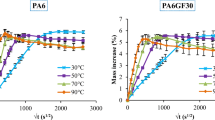Abstract
The aim of this study is to evaluate the effect of the humidity on the long term behaviour of glass fiber reinforced thermoplastic in fatigue. Two sets of samples were studied, one set contained 0.2 wt% of water, the second 3.5 wt%. The fatigue tests are performed at a 10 Hz frequency, at room temperature and two various relative humidity ratios, 50% RH and 96% RH. The S–N curve of dried samples (0.2%) is above the one of humid samples (3.5%), the endurance limit at 107 cycles for dried samples is equal to 40 MPa against 35 MPa for the second set. For a given strain, the fatigue life is higher for humid samples because the induced stress is much lower due to the plasticizing effect of water. Though the tests are carried out at room temperature (23 °C), the sample temperature at the surface reaches values higher than Tg and whatever the applied strain, the matrix is in a rubbery state when the fracture occurs. On the basis of S.E.M. examinations, the following scenario is proposed: crack initiation at the fiber end, crack propagation along the fiber sides going with debonding, then crack propagation in the rubbery matrix.












Similar content being viewed by others
References
Trotignon JP, Tcharkhtchi A (1996) Macromol Symp 108:231
Dally JW, Carrillo DH (1969) Polym Eng Sci 9:434
Di Benedetto AT, Salee G (1975) Polym Eng Sci 15:243
Bretz PE, Hertzberg RW, Manson JA (1987) J Mater Sci 22:4015
Horst JJ, Damage 96 Conference, Fukuako, Japan, June 1996
Mark JE (1996) Physical properties of polymers handbook. American Chemical Society
Trotignon JP (1995) Polymer Testing 14:129
Mc Crum NG, Read BE, Williams G (1967) Anelastic and dielectric effects in polymeric solids. Wiley, New York
Papir YS, Kapur S, Rogers CE, Baer E (1972) J Polym Sci A2 10:1305
Wright WW (1981) Composites 12:201
Kohan MI (1973) Nylon plastics. Wiley, New York
Noda K, Takahara A, Kajiyama T (2001) Polymer 42:5803
Van Krevelen DW, Hoftyzer PJ (1976) Properties of polymers, 2nd edn. Elsevier, New York, p 283
Rittel D (2000) Mech Mater 32:131
Rittel D, Eliash N, Halary JL (2003) Polymer 44:2817
Molinari A, Germain Y (1996) Int J Solids 33(23):3439
Chandra R, Singh SP, Gupta K (1999) Compos Struct 46:41
Author information
Authors and Affiliations
Corresponding author
Rights and permissions
About this article
Cite this article
Barbouchi, S., Bellenger, V., Tcharkhtchi, A. et al. Effect of water on the fatigue behaviour of a pa66/glass fibers composite material. J Mater Sci 42, 2181–2188 (2007). https://doi.org/10.1007/s10853-006-1011-x
Received:
Accepted:
Published:
Issue Date:
DOI: https://doi.org/10.1007/s10853-006-1011-x




